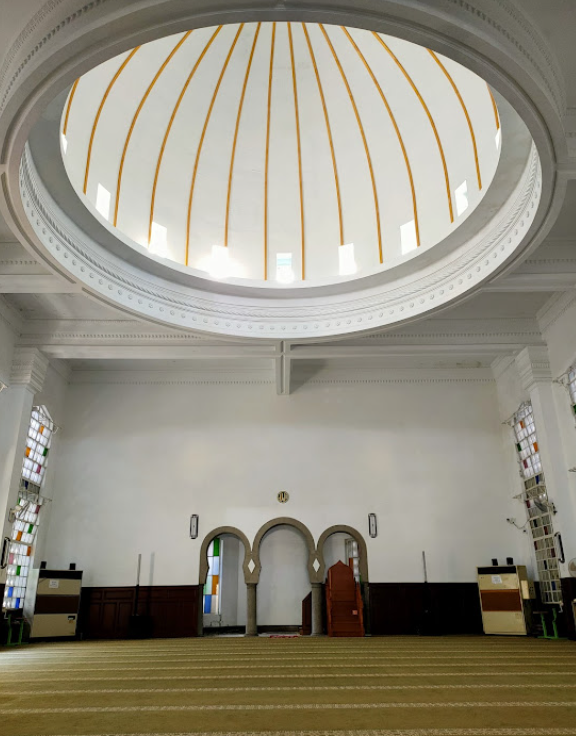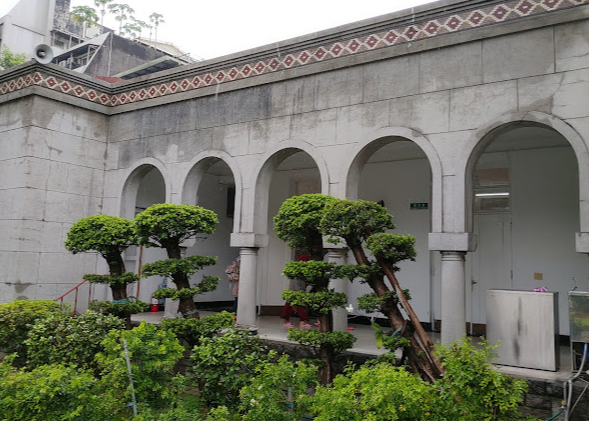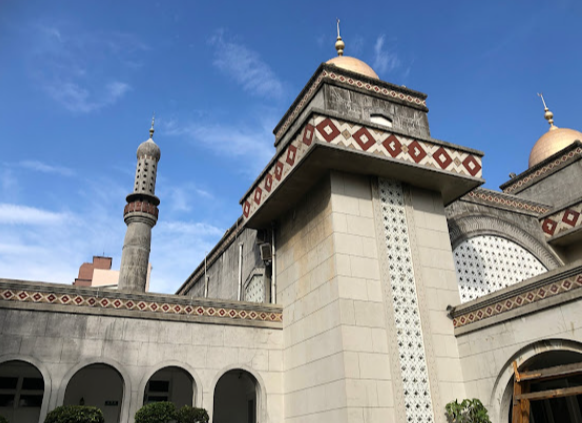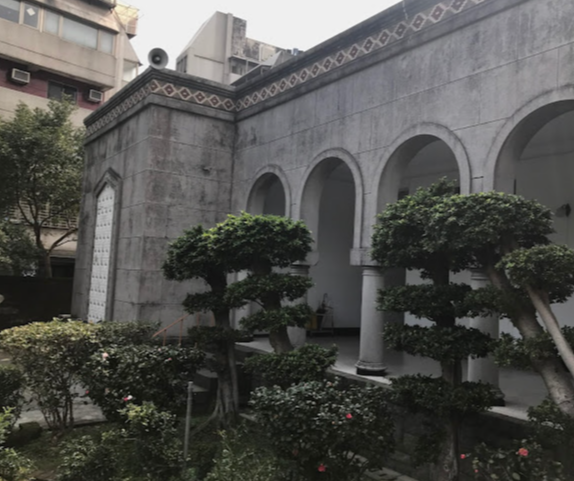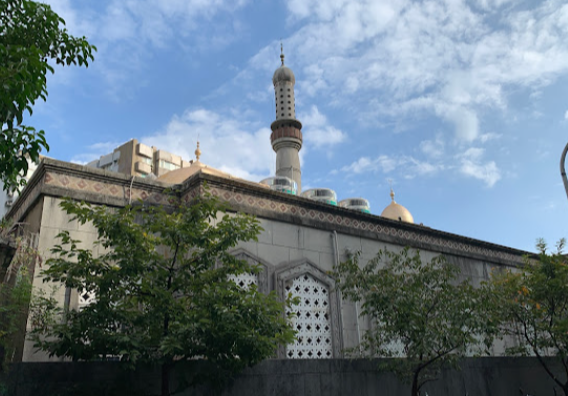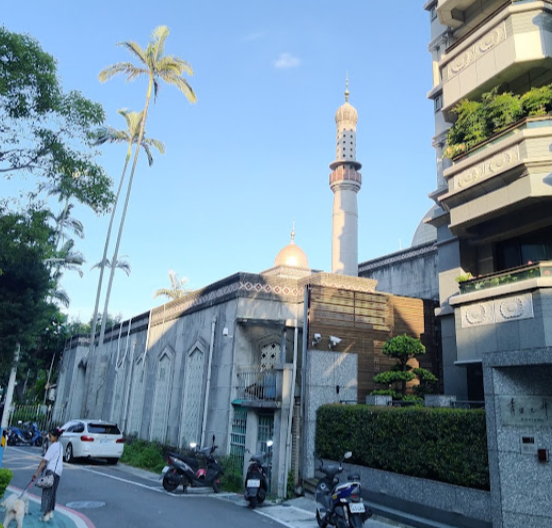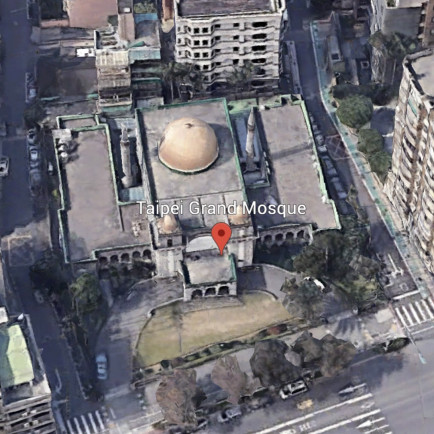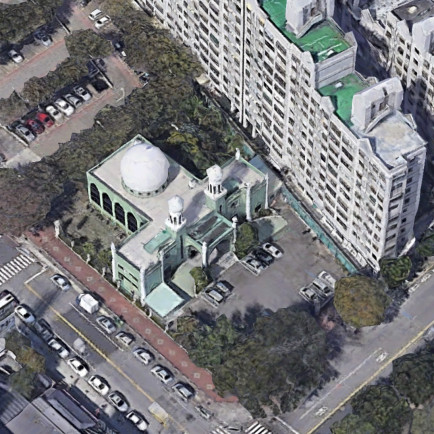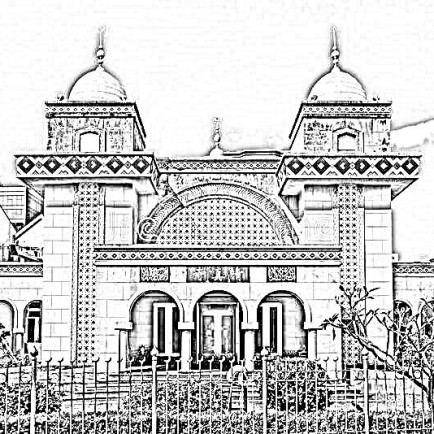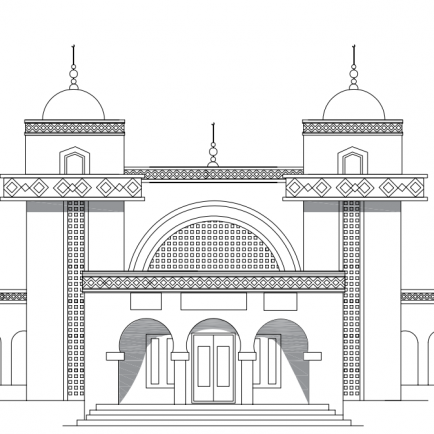Taipei Grand Mosque
History
In the latter part of the 1950s after the end of Chinese Civil War and the relocation of the Nationalist Government from Mainland China to Taiwan, Director-General of the CMA Bai Chongxi and ROC Minister of Foreign Affairs George Yeh proposed the construction of a bigger Islamic-style mosque which was designed by the famous architect Yang Cho-cheng. Under the leader Bai Chongxi, director-general Shi Zizhou (時子周) and the board chairman Chang Zixuan (常子萱), the mosque was constructed by the Continental Engineering Corporation on a 2,747 m2 land donated by the government at the Xinsheng South Street (新生南路). ROC Vice President Chen Cheng led the inauguration ceremony of the mosque on 13 April 1960.
The cost of the construction was covered by the CMA with funding of $150,000 from the Shah of Iran and King of Jordan, $100,000 loaned by the Kuomintang government and loan from the Bank of Taiwan. The congregation had already repaid half of the bank loan by that time when the ROC government decided to exempt them from having to repay the remaining.
The mosque has strong ties to Saudi Arabia which continues to provide financial support to the mosque. Visiting Saudi Imams come to preach at the mosque during Ramadan. In 1971 the mosque was visited by King Faisal.
The mosque has been visited by other head of states, such as King Hussein of Jordan, Prime Minister Tunku Abdul Rahman of Malaysia and many other prominent Muslim leaders.
Urban and Architectural
Taipei Grand Mosque was built according to Islamic religion and Arabic architecture. It was designed by architect Yang Cho-cheng, the same architect that designed the Taipei Grand Hotel, Chiang Kai-shek Memorial Hall, National Theater and Concert Hall and many other landmark buildings in Taiwan. The main structure was built using reinforced concrete.
The mosque has an enormous greenish-bronze domed roof at a 15 meters height and 15 meters of diameter, and is supported entirely without beams. It is wrapped by brass sheets. As years gone by, oxidation with air has turned the dome from spangle to verdigris. The dome has two Byzantium style onion-shaped-spires. Crescent decorations sit at the tip of the spires and at the iron railings.
The mosque also has two minarets with a height of 20 meters each located at both ends of the building. The minarets are grey in color with a red-colored neck and an onion-shaped spire on top. The design uses a blend of Taiwanese and Central Asian materials.
It is the largest mosque in Taiwan with a total area of 2,747 square meters and an expansive prayer hall with a height and width of 15 meters. The hall was built according to Islamic traditions where there is Islamic geometric art on the windowpanes. It can accommodate up to 1,000 worshippers and is adorned with handmade Persian rugs and chandeliers presented by kings of countries with allies with the ROC. Initially, the prayer hall was only located on the ground floor of the mosque. But due to the increasing number of Muslims attending prayers, a second floor was added above the main prayer hall floor to accommodate the female worshipers.
Surrounding the main prayer hall is the Roman-style colonnade and Byzantium architectural style. The mosque corridors are filled with corbel arches that extend to both ends. The width and height of the column of the arches is harmoniously proportional. The square pegs of the arches are smoothed with round edges. Outer walls of the mosque are made by bricks and cut stones, decorated with mosaic tiles.
There are two Arabian date palm trees located at the mosque front yard garden.
Description
Taipei Mosque, the full name of the Taipei Mosque of the Republic of China , is located on Xinsheng South Road , Daan District , Taipei City , Taiwan . It is the most famous and important place of worship for Islam (also known as Islam ) in Taiwan .
Architect: Yang Cho-cheng
Details
Location
No. 62號, Section 2, Xinsheng S Rd, Da’an District, Taipei City, Taiwan 10650
Worshippers
1000
Owners
Chinese Muslim Association (CMA) in Nanking
Architect Name
Year of Build
1948
Area
2,747 m2
Drawings
Map
History
In the latter part of the 1950s after the end of Chinese Civil War and the relocation of the Nationalist Government from Mainland China to Taiwan, Director-General of the CMA Bai Chongxi and ROC Minister of Foreign Affairs George Yeh proposed the construction of a bigger Islamic-style mosque which was designed by the famous architect Yang Cho-cheng. Under the leader Bai Chongxi, director-general Shi Zizhou (時子周) and the board chairman Chang Zixuan (常子萱), the mosque was constructed by the Continental Engineering Corporation on a 2,747 m2 land donated by the government at the Xinsheng South Street (新生南路). ROC Vice President Chen Cheng led the inauguration ceremony of the mosque on 13 April 1960.
The cost of the construction was covered by the CMA with funding of $150,000 from the Shah of Iran and King of Jordan, $100,000 loaned by the Kuomintang government and loan from the Bank of Taiwan. The congregation had already repaid half of the bank loan by that time when the ROC government decided to exempt them from having to repay the remaining.
The mosque has strong ties to Saudi Arabia which continues to provide financial support to the mosque. Visiting Saudi Imams come to preach at the mosque during Ramadan. In 1971 the mosque was visited by King Faisal.
The mosque has been visited by other head of states, such as King Hussein of Jordan, Prime Minister Tunku Abdul Rahman of Malaysia and many other prominent Muslim leaders.
Urban and Architectural
Taipei Grand Mosque was built according to Islamic religion and Arabic architecture. It was designed by architect Yang Cho-cheng, the same architect that designed the Taipei Grand Hotel, Chiang Kai-shek Memorial Hall, National Theater and Concert Hall and many other landmark buildings in Taiwan. The main structure was built using reinforced concrete.
The mosque has an enormous greenish-bronze domed roof at a 15 meters height and 15 meters of diameter, and is supported entirely without beams. It is wrapped by brass sheets. As years gone by, oxidation with air has turned the dome from spangle to verdigris. The dome has two Byzantium style onion-shaped-spires. Crescent decorations sit at the tip of the spires and at the iron railings.
The mosque also has two minarets with a height of 20 meters each located at both ends of the building. The minarets are grey in color with a red-colored neck and an onion-shaped spire on top. The design uses a blend of Taiwanese and Central Asian materials.
It is the largest mosque in Taiwan with a total area of 2,747 square meters and an expansive prayer hall with a height and width of 15 meters. The hall was built according to Islamic traditions where there is Islamic geometric art on the windowpanes. It can accommodate up to 1,000 worshippers and is adorned with handmade Persian rugs and chandeliers presented by kings of countries with allies with the ROC. Initially, the prayer hall was only located on the ground floor of the mosque. But due to the increasing number of Muslims attending prayers, a second floor was added above the main prayer hall floor to accommodate the female worshipers.
Surrounding the main prayer hall is the Roman-style colonnade and Byzantium architectural style. The mosque corridors are filled with corbel arches that extend to both ends. The width and height of the column of the arches is harmoniously proportional. The square pegs of the arches are smoothed with round edges. Outer walls of the mosque are made by bricks and cut stones, decorated with mosaic tiles.
There are two Arabian date palm trees located at the mosque front yard garden.
Description
Taipei Mosque, the full name of the Taipei Mosque of the Republic of China , is located on Xinsheng South Road , Daan District , Taipei City , Taiwan . It is the most famous and important place of worship for Islam (also known as Islam ) in Taiwan .
Architect: Yang Cho-cheng


